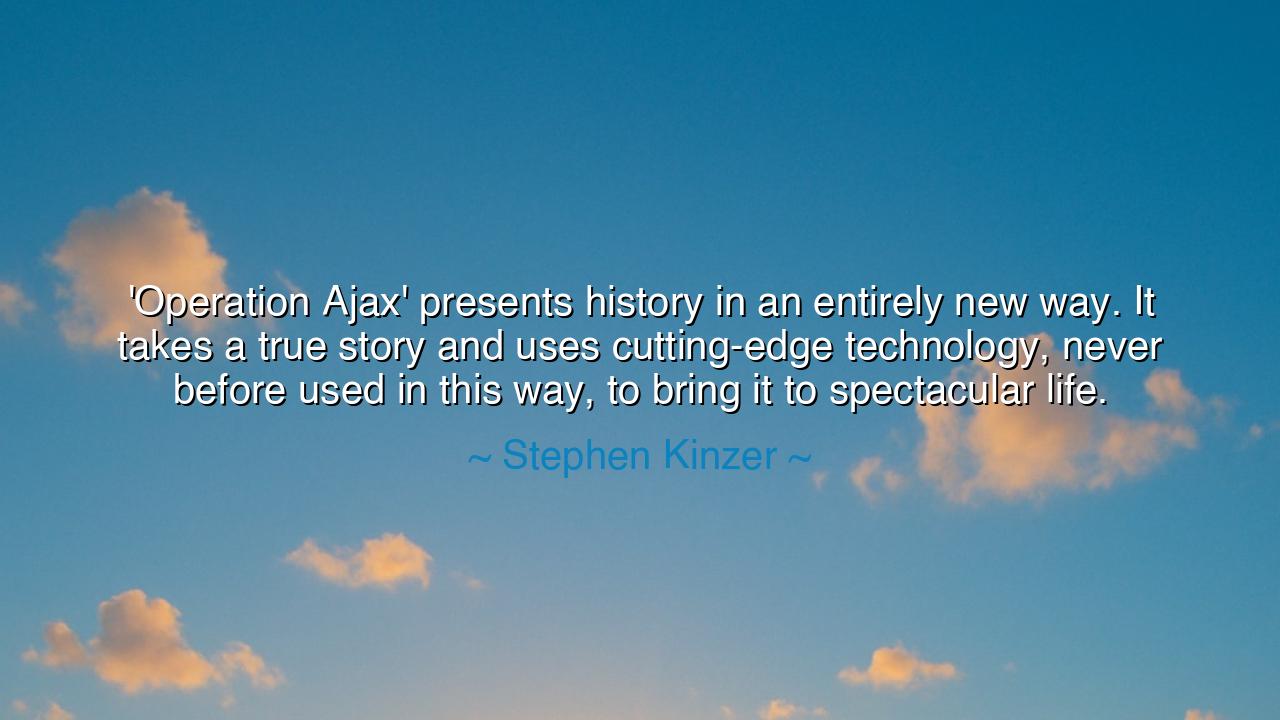
'Operation Ajax' presents history in an entirely new way. It
'Operation Ajax' presents history in an entirely new way. It takes a true story and uses cutting-edge technology, never before used in this way, to bring it to spectacular life.






When Stephen Kinzer declared, “'Operation Ajax' presents history in an entirely new way. It takes a true story and uses cutting-edge technology, never before used in this way, to bring it to spectacular life,” he spoke with the authority of one who understands the profound power of storytelling and innovation combined. His words illuminate a truth that resonates across the ages: that history is not merely a chronicle of events, but a living narrative, capable of being experienced, felt, and understood in ways that transcend the written word. By employing new technologies, Operation Ajax transforms history into an immersive journey, bridging the past and present in a way that awakens both intellect and emotion.
The origin of this reflection lies in Kinzer’s own scholarship and journalistic work on foreign interventions, particularly the 1953 coup in Iran orchestrated by the United States and the United Kingdom. Operation Ajax, the book and its associated multimedia presentations, seeks to illuminate a pivotal event often obscured in conventional histories. Kinzer emphasizes that the innovation is not in the story itself — which is factual and well-documented — but in the method of presentation, using technology to make the complexities, consequences, and human experiences tangible for contemporary audiences.
Kinzer’s insight echoes the wisdom of the ancients, who understood that history must be experienced as well as remembered. The Roman historian Livy and the Greek chronicler Herodotus did not merely record events; they dramatized them, weaving narratives that evoked emotion and reflection, bringing the deeds of past generations into the minds and hearts of their readers. In the same manner, Kinzer argues that technological innovation allows us to reanimate history, to feel its tension, understand its stakes, and witness its lessons as if they were unfolding before our eyes.
Consider the story of the 1953 Iranian coup itself. Mossadegh, Iran’s democratically elected prime minister, was overthrown in a covert operation orchestrated by foreign powers, leading to decades of political turmoil. Traditional histories recount the facts, but they often fail to convey the experience of those who lived through it, the tension, the fear, and the complexity of human motives. By integrating technology and storytelling, Operation Ajax immerses audiences in this historical moment, showing how innovation in presentation can deepen understanding and empathy, revealing truths that conventional narrative alone might obscure.
Kinzer’s words also carry a broader message about the intersection of technology and human understanding. Just as the printing press allowed ideas to spread across continents, and as cinema brought distant worlds to vivid life, the tools we use to convey history shape how it is perceived and remembered. The use of cutting-edge technology in Operation Ajax is not merely spectacle; it is a tool of clarity and comprehension, making complex geopolitical events accessible, engaging, and resonant for a new generation.
The lesson extends beyond historical storytelling into every endeavor of human knowledge. Innovation in the method of communication, whether in education, art, or science, allows insights to reach minds more effectively and profoundly. Kinzer reminds us that the medium shapes the message, and that embracing new tools can transform understanding, giving life to truths that might otherwise remain abstract or distant. By presenting history in a compelling and immersive manner, we honor both the past and the potential of human cognition.
O listener, take this teaching as a call to embrace both truth and creativity. Seek to present knowledge not only accurately, but with imagination, clarity, and tools that resonate with the senses and the heart. Learn from the past, and use every means at your disposal to ensure that its lessons endure, inspire, and illuminate. Kinzer’s reflection urges us to recognize that innovation in storytelling is not mere ornamentation—it is an ethical commitment to truth and understanding.
In the end, Stephen Kinzer teaches that history, when combined with innovation, becomes alive. It is not only the story of events, but a vehicle for empathy, comprehension, and transformation. Operation Ajax exemplifies how courage, scholarship, and technology together can bring the past to life, reminding us that the lessons of history are most profound when experienced, not merely recited. To honor this truth is to engage with history in a way that enlightens, educates, and endures.






AAdministratorAdministrator
Welcome, honored guests. Please leave a comment, we will respond soon